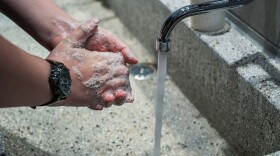The energy that lights up, turns on, cools and heats our lives leaves... a trail of waste. And the waste from the gas drilling known as “fracking” is often radioactive. Reporter Glynis Board and the nonprofit Center for Public Integrity found that spotty regulation of this “hot” waste creates ripe conditions for improper disposal.
***
FULL SCRIPT
INTRO: The energy that lights up, turns on, cools and heats our lives leaves... a trail of waste. And the waste from the gas drilling known as “fracking” is often radioactive. Reporter Glynis Board and the nonprofit Center for Public Integrity found that spotty regulation of this “hot” waste creates ripe conditions for improper disposal. Here’s Glynis with the story.
Glynis: Last August a convoy of trucks traveled from northern West Virginia to Irvine, Kentucky - a small town near the Kentucky River, where Appalachian hills give way to rolling farm country.
:50 VS This is our home place this is roots for us we’ve owned it since 1800s [Nat - Roadway]
Glynis: Vivian Smith and her husband Denny live next to a high school and across the road from a landfill.That landfill is under investigation by state agencies for improperly accepting tons of radioactive oil and gas waste.
Vivian: “We are getting older, we’re in our 70s, and we feel like we’re kind of vulnerable to illnesses with that what’s going on at the landfill.”
The question on everyone’s mind: How did this happen?
A report from the Center for Public Integrity calls this radioactive waste “orphaned” because no one government agency is fully managing it. It’s exempt from federal disposal laws, so each state has to figure out its own plan. Ohio, for example, hasn’t formalized waste rules. New York banned fracking but still allows disposal of fracking waste “with little oversight,” according to the Center.
And states agencies aren’t the only ones struggling - industry is, too. [NAT - Antero pad]
Waltz: "We’re at the entrance to our Charlene pad.”
Board: Tom Waltz is a petroleum engineer who works for Antero Resources - the 8th-largest gas drilling company in the U.S.
Waltz: “What you’re seeing right off the bat here - eight large green tanks. They would hold our produced water that the producing wells make once they go online."
Board: “Produced water” is one form of drilling waste which brings radioactive materials naturally found in the earth to the surface. Antero has to dispose of hundreds of thousands of barrels of this stuff. The easiest way to get rid of it is to inject it back into the ground. But that can lead to pollution and earthquakes, so processing the water is becoming more attractive.
[NAT construction] Not far away, Antero is currently spending millions to construct this huge facility that will do just that. Processing the wastewater will vastly reduce Antero’s need to inject waste, but leave concentrated low-level radioactive solids behind. At its peak, this facility will create 180 tons of this sludge every day. Antero civil engineer Conrad Baston says it will be shipped offsite for disposal.
“Given some of the flux in the regulatory environment with regard to those sludges, we’ve elected to take those sludges to a landfill that’s currently licensed to accept it.”
Baston can’t tell me which facilities or where. West Virginia’s Department of Environmental Protection says no approved facilities exist in this state, so the waste will have to cross state lines.
Records filed with the West Virginia Bureau for Public Health show that last summer a company that Antero contracted produced the 400 tons of waste that ended up in the landfill in Irvine, Kentucky...across the road from Vivian Smith.
“Knowing that there was nothing going on to protect us,” I think it’s like the henhouse was not guarded and the fox got in.”
This waste isn’t as dangerous as nuclear waste. But it’s potentially cancer-causing if ingested. So dust is dangerous, and it would be really bad if it got into groundwater.
Officials at the landfill itself said it couldn’t comment while under investigation-- an investigation the Smiths hope will shed light on the risks they may now have to live with.
Ohio Valley ReSource is a public media partnership covering the region’s economic transition. It is made possible with support from the Corporation for Public Broadcasting and WEKU.






